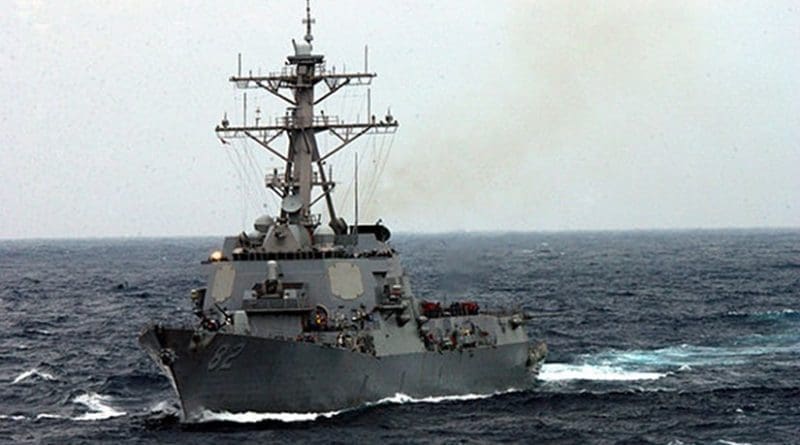Avert Sino-US Showdown Over South China Sea – OpEd
By Sudhanshu Tripathi*
With the US piling up its warships with fighter planes and stationing troops in South China Sea, where China has hectically been active since long past, the likely scenario bodes bad omen with all chances of a major regional war breaking out between the two which may include regional navies like Japan, Australia and South Korea.
Indeed, the mounting tensions in South China Sea are due to China’s own creation which cropped up there few years back – in 2011 – because Beijing advanced its sovereign claim over entire South China Sea as its maritime territory citing some historical evidences. But that claim was rejected by a five-member panel from the Permanent Court of Arbitration (PCA) in The Hague, Netherlands on July 12, 2016, while deciding on Philippines’ complaint lodged in 2013 for arbitration on grounds of alleged Chinese infringement into Manila’s Exclusive Economic Zone (EEZ), under clauses of violation of the United Nations Treaty governing “Laws of the Sea” (UNCLOS) to which China is also a signatory. Unfortunately, this legal defeat has made Beijing more aggressive and irresponsible in its behaviour as it has resumed threatening all the littoral states of Asia-Pacific including India, thereby endangering the already tense scenario in this region.
In the recent past, while pursuing its ill-founded claim, China not only raised its naval presence with increasing number of naval warships, submarines and aerial support and monitoring and performing regular naval exercises with bold display of its awesome military power but also creating artificial reefs in the ocean with a view to reclaim land amidst sea for stationing troops, armaments and other logistical purposes. Obviously, this highhandedness was bound to ignite intense reactions not only among littoral powers in the Asia-Pacific – now rechristened Indo-Pacific – like Southeast Asian countries including India but also the distant regional naval powers including Japan, Australia and the US.
In Southeast Asia, China is already engaged in several disputes over sovereignty of islands in South China Sea. It has disputes with Philippines, Vietnam and Malaysia over the control of many islands and reefs as well.
The US has been carefully monitoring all these developments as it has its precious stakes in this region particularly owning its strategic relations with many of Southeast countries and also major powers in the Far East. It has also to ensure and monitor the safe and uninterrupted passage of maritime trade and commerce passing through different sea-lanes in South China Sea region, connecting East Asia with Persian Gulf and West Asia and beyond which would have been stopped pending China’s permission had Beijing’s claim proved its legal validity. The US is also well aware that global geopolitics is moving towards East after around two hundred and half years from its traditional Euro-Atlantic centre of power. That is why the US had already concluded a significant military agreement with Australia in 2011 following its “Asia Pivot” policy having a covert agenda to contain China’s imperialistic-militarist aggressions in the Asia-Pacific so as to provide a security cover to the smaller regional powers and also to establish that the US is still the global power and also maintains its hegemony all across the world.
As a scholar Martin Jacques also predicts in his oft-cited book “When China Rules the World” that China will surpass the US and will become a dominant global leader with none to challenge its hegemony. Obviously, the US is to remove such floating confusions about its sagging global power image and that has, now, brought it into full steam in South China Sea because Beijing has offered it a new opportunity.
Indeed, these events do not bode well for the peace and security of the Indo-Pacific region because China too is very image conscious and particularly because it is still suffering from “Middle Kingdom Complex”, which has propelled it adopt novel ways, like the latest Silk Road and Maritime Silk Road initiative, to assert it regional and global hegemony according to an American scholar, Randall Peerenboom. Obviously, if war begins between the two, it may end up involving Australia, Japan, South Korea and US’ other NATO allies besides Southeast nations, and also India. Its further advancement will inevitably lead to a Third World War which will very horrible as all the key parties in the likely war are, today, nuclear powered belligerents.
To avert the possibility of having another major war destroy this world, China must abide by the decision of the Hague Arbitration. Both sides ought to observe restraint and must seek some diplomatic solution with the help of the United Nations. If China disagrees, it can be diplomatically isolated, although the cost of doing the same will be too high to pay. Here India, being a founder member of the Non-Aligned Movement (NAM) and also a prominent South Asian power, can play a meaningful role in resolving the imminent crisis by evolving fresh global initiative towards peace and non-violence in the world as “nothing is beyond human endeavour”.
*Dr. Sudhanshu Tripathi is Associate Professor of Political Science, MDPG College, Pratapgarh, Uttar Pradesh. Comments and suggestions on this article can be sent on: [email protected]

